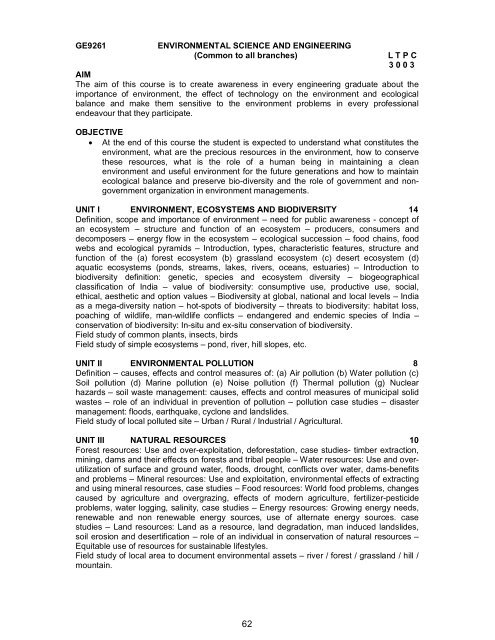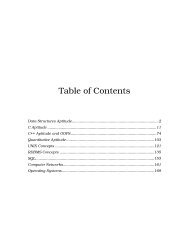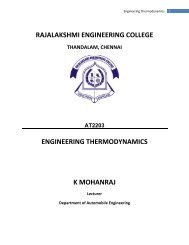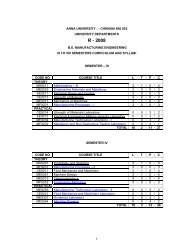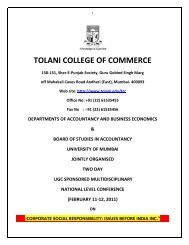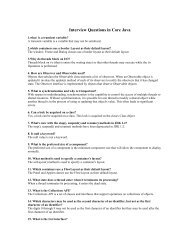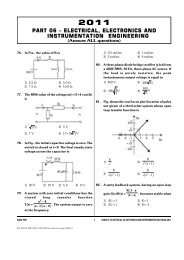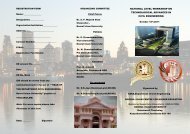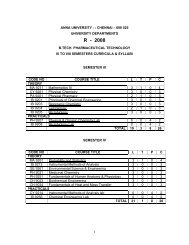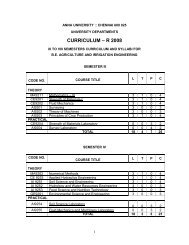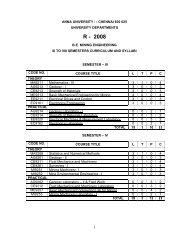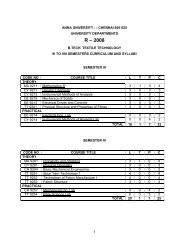b.tech. ceramic technology - Technicalsymposium
b.tech. ceramic technology - Technicalsymposium
b.tech. ceramic technology - Technicalsymposium
Create successful ePaper yourself
Turn your PDF publications into a flip-book with our unique Google optimized e-Paper software.
GE9261ENVIRONMENTAL SCIENCE AND ENGINEERING(Common to all branches)L T P C3 0 0 3AIMThe aim of this course is to create awareness in every engineering graduate about theimportance of environment, the effect of <strong>tech</strong>nology on the environment and ecologicalbalance and make them sensitive to the environment problems in every professionalendeavour that they participate.OBJECTIVE At the end of this course the student is expected to understand what constitutes theenvironment, what are the precious resources in the environment, how to conservethese resources, what is the role of a human being in maintaining a cleanenvironment and useful environment for the future generations and how to maintainecological balance and preserve bio-diversity and the role of government and nongovernmentorganization in environment managements.UNIT I ENVIRONMENT, ECOSYSTEMS AND BIODIVERSITY 14Definition, scope and importance of environment – need for public awareness - concept ofan ecosystem – structure and function of an ecosystem – producers, consumers anddecomposers – energy flow in the ecosystem – ecological succession – food chains, foodwebs and ecological pyramids – Introduction, types, characteristic features, structure andfunction of the (a) forest ecosystem (b) grassland ecosystem (c) desert ecosystem (d)aquatic ecosystems (ponds, streams, lakes, rivers, oceans, estuaries) – Introduction tobiodiversity definition: genetic, species and ecosystem diversity – biogeographicalclassification of India – value of biodiversity: consumptive use, productive use, social,ethical, aesthetic and option values – Biodiversity at global, national and local levels – Indiaas a mega-diversity nation – hot-spots of biodiversity – threats to biodiversity: habitat loss,poaching of wildlife, man-wildlife conflicts – endangered and endemic species of India –conservation of biodiversity: In-situ and ex-situ conservation of biodiversity.Field study of common plants, insects, birdsField study of simple ecosystems – pond, river, hill slopes, etc.UNIT II ENVIRONMENTAL POLLUTION 8Definition – causes, effects and control measures of: (a) Air pollution (b) Water pollution (c)Soil pollution (d) Marine pollution (e) Noise pollution (f) Thermal pollution (g) Nuclearhazards – soil waste management: causes, effects and control measures of municipal solidwastes – role of an individual in prevention of pollution – pollution case studies – disastermanagement: floods, earthquake, cyclone and landslides.Field study of local polluted site – Urban / Rural / Industrial / Agricultural.UNIT III NATURAL RESOURCES 10Forest resources: Use and over-exploitation, deforestation, case studies- timber extraction,mining, dams and their effects on forests and tribal people – Water resources: Use and overutilizationof surface and ground water, floods, drought, conflicts over water, dams-benefitsand problems – Mineral resources: Use and exploitation, environmental effects of extractingand using mineral resources, case studies – Food resources: World food problems, changescaused by agriculture and overgrazing, effects of modern agriculture, fertilizer-pesticideproblems, water logging, salinity, case studies – Energy resources: Growing energy needs,renewable and non renewable energy sources, use of alternate energy sources. casestudies – Land resources: Land as a resource, land degradation, man induced landslides,soil erosion and desertification – role of an individual in conservation of natural resources –Equitable use of resources for sustainable lifestyles.Field study of local area to document environmental assets – river / forest / grassland / hill /mountain.62


